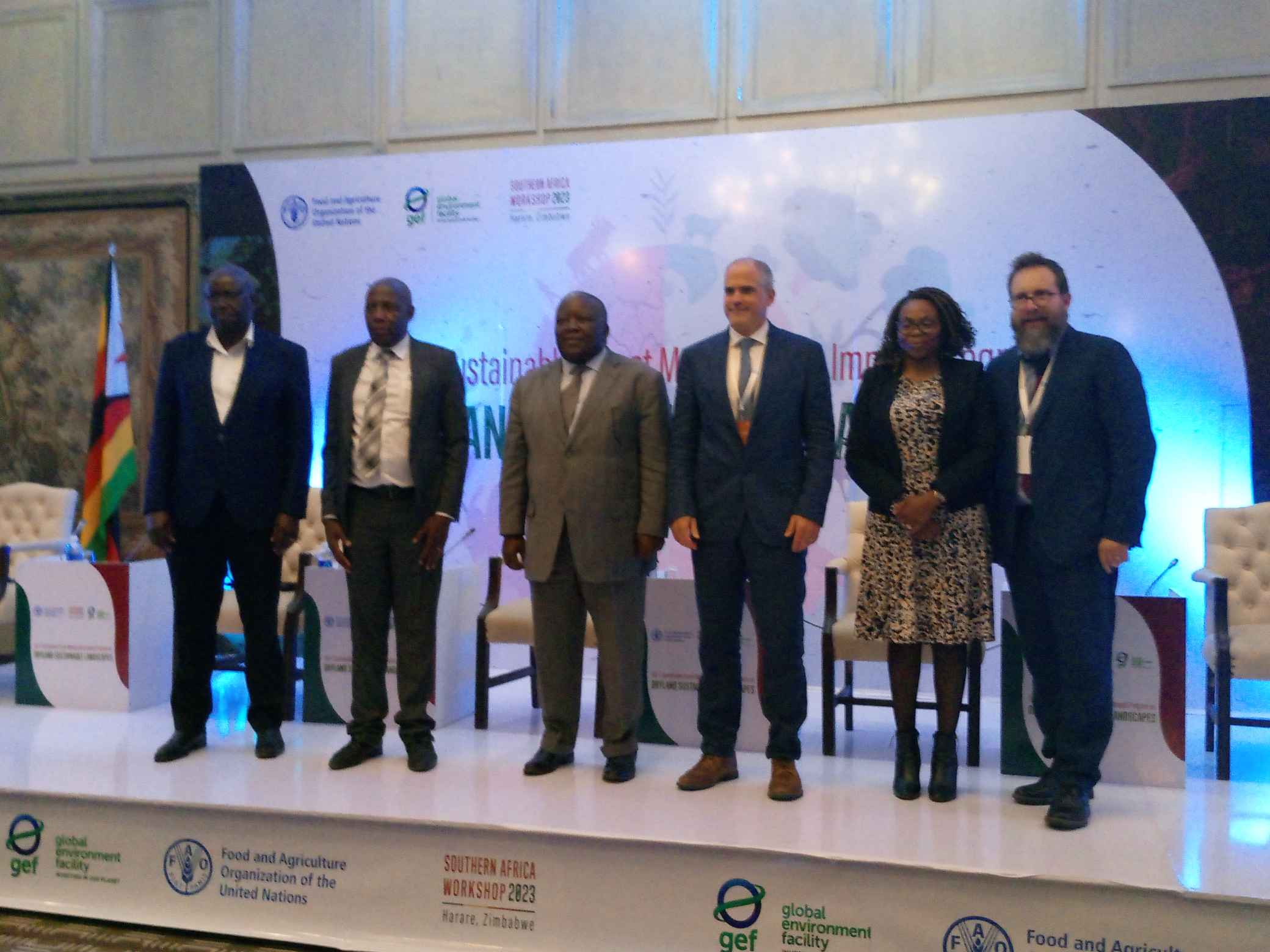|
Getting your Trinity Audio player ready...
|
Zimbabwe and the Drylands Sustainable Landscapes – Impact Programme (DSL-IP) Southern Africa Regional Workshop is convening to find ways to respond to Southern Africa’s environmental challenges particularly desertification, land degradation, and the impacts of drought.
Addressing stakeholders during the official workshop running from 22 to 26 May 2023 in Harare, Ambassador Raphael Tayerera Faranisi, the Permanent Secretary in the Ministry of Environment, Climate, Tourism and Hospitality Industry said Africa loses an estimated 5 million hectares of tropical forest per year and land degradation is estimated to affect about 230 million hectares annually.
He said Zimbabwe has not been spared from this challenge; an estimated 36% of the country’s land area is degraded mainly due to anthropogenic and natural causes.
“Degraded areas in the country are characterised by sheet, rill, and gully erosion, low land cover and biodiversity, and clusters of invasive alien species to mention a few. The objective of the Zimbabwe Child project is therefore to avoid, reduce and reverse further degradation, desertification, and deforestation of land and ecosystems in drylands of the Save and Runde sub-basins through the implementation of sustainable land and forest management practices in the landscapes.
“It is pleasing to note that the programme significantly contributes to the achievement of global targets, several Sustainable Development Goals, the objectives of the Great Green Wall Initiative as well as the national level Land Degradation Neutrality Targets (LDN) set under the United Nations Convention to Combat Desertification (UNCCD). Further, the project feeds into the Zimbabwe economic blueprint, the National Development Strategy 1 (2021-2025). The national blueprint prioritizes community empowerment, stakeholder capacity strengthening, restoration of degraded land, the protection of wetlands, and veld fire management. It is therefore noteworthy that this project feeds directly into the national development strategy,” Ambassador Faranisi said.
The project focuses on rural communities, which make up 60% of the country’s populace and largely rely on land and land-based resources as their major safety net for survival. This project will enhance community benefits from the environment through business development and ensure the sustainable utilisation of natural resources.
The Ministry’s strategy for this project is to demonstrate effective approaches for sustainable land and forest management in order to influence policy and the integration of sustainable environmental management across sectors.
The Zimbabwe child project has achieved a number of milestones, some of which include a smooth inception at the national level, project rollout down to the lowest levels, and the establishment and/or resuscitation of coordination committees.
The highest committee, the Project Steering Committee (PSC) is the ultimate decision-making body that gives strategic guidance to the project to ensure the achievement of project outcomes and objectives. This 16-member committee is chaired by the Ministry of Environment, Climate, Tourism, and Hospitality Industry and has a multi-sector representation of government officials and key ministries, corporates, and civil society organisations.
At a technical level, a committee of focal persons from partner institutions is in place. This committee directly links with the Project Management Unit and coordinates the programming of project activities at the national level. Each district, among the eight (8) districts in the project has a similar committee that is involved in the day-to-day running of project activities through and with community-level structures.
Guided by assessments carried out, some project activities have commenced at the landscape, and these include awareness and capacity-building programmes in schools and among farmers, seed multiplication as well nursery establishment in preparation for the coming rainy season.
“We owe the successful take-off of this project to the implementation of the “Whole of Government” and “Whole of Society” approaches that have enhanced the participation of all relevant stakeholders; Government, civil society organisations, corporates, and communities in the planning and implementation of project interventions. The engagement of every key stakeholder and their involvement in planning builds a sense of ownership of the project and ensures its sustainability.
“Learning from previous experiences, communities actively participate in programmes that provide an immediate benefit. Land restoration interventions in this project are therefore intertwined with community livelihood projects,” Ambassador Faranisi added
The project leverages and draws lessons from previous transformative projects implemented in the country, including GEF projects. We are excited about the regional collaboration brought about by this project and the knowledge exchange platforms from which the country can draw lessons.
Challenges faced in restoration projects, in general, include the unavailability of equipment locally and options for effective land management, particularly the eradication of invasive alien species; the difficulty in managing fragile soils and the slow and low adoption of alternative energy sources by communities. It is through this knowledge exchange process that countries learn from each other.
One notable challenge faced in this project at inception stakeholders had to deal with was the management of stakeholder and community expectations in terms of the selection of project sites and scope. Communities and stakeholders would see the project as a panacea for solving a myriad of their declining land productivity and would therefore expect immediate remedial action. However, experience tells us that land restoration activities require patience.
Attending the workshop are representatives from FAO Subregional Office; FAO Forestry Division; the Great Green Wall Initiative, of the African Union Commission; GEF 7 Impact Programs Drylands; International Implementing Partners; Officials from the SADC Regional Office; Global Environment Facility (GEF) Operational Focal Points; United Nations Convention to Combat Desertification (UNCCD) National Focal Points; Representatives of Government Departments and Ministries; GEF 7 Child Projects Management Units (PMU); and Local stakeholders and partners.






